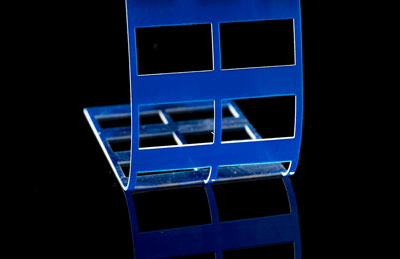| Posted: Feb 19, 2018 | |
Creating highly tunable adhesives with Kirigami-inspired structures |
|
| (Nanowerk Spotlight) The development of smart glues, with controlled and tunable adhesion, is driven to a large degree by potential applications in biomedical systems, robotics, and manufacturing. For instance, wearable electronics directly attached to the skin and other stick-on electronics rely on adhesives that bond certain strategic regions of the circuits to a wide range of surfaces including skin (see our previous Nanowerk Spotlight: Nanotechnology electronics at the tip of your gloved finger). Researchers also have developed a reversible adhesion method for printing electronics on a variety of tricky surfaces such as clothes, plastic and leather. | |
| One area of nanostructure-based adhesives has been inspired by geckos. Whereas conventional pressure-sensitive adhesives, based on viscoelastic polymers, are either strong and difficult to remove (like duct tape) or weak and easy to remove (like sticky notes), the gecko adhesive effect differs dramatically. It is based on the contact surface of the tip of tiny hairs, which gives rise to optimal adhesion to a substrate via molecular interaction forces. | |
| While there are numerous reports on enhancing stickiness through chemical treatments and microfabrication of hairy structures on the adhesive layer, a novel approach has now been introduced by researchers from Iowa State University. | |
| They show that by carefully designing arrays of cuts in an adhesive film, the stickiness can not only be tuned by a factor of ∼100 across a single sheet, but also be decreased for an easy-release purpose. | |
| These kirigami-inspired structures at interfaces provide a mechanism to spatially control and enhance adhesion strength while providing directional characteristics for high-capacity, easy-release interfaces. This could lead to the creation of highly tunable adhesives. | |
| The team has reported their findings in ACS Applied Materials & Interfaces ("Kirigami-Inspired Structures for Smart Adhesion"). | |
| Kirigami is an ancient Japanese art of cutting and folding paper to obtain 3D shapes. By introducing kirigami-inspired cuts into adhesive films a new mechanism arises to spatially control and enhance adhesion strength, where counter-intuitively, the scientists show that a cut adhesive can be 10 times more adhesive than an uncut film. | |
| In addition, the cut patterns provide high adhesive capacity but easy-release characteristics, by changing the peeling direction. | |
| "Our work can provide insights for tuning adhesion without relying on chemical treatment or micro or nanostructured surfaces and can be created with rapid fabrication techniques, such as laser machining," Michael D. Bartlett an Assistant Professor in Materials Science and Engineering at Iowa State, tells Nanowerk. | |
 |
|
| Schematics of kirigami-inspired adhesives. This model consists of interconnects supported by an adhesive with voids between interconnects. (Image: Soft Materials and Structures Lab, Iowa State University) | |
| "There was a study published in the 70’s that investigated the effect of rigid patterns on soft adhesives and recently the work was revived with a very nice, rigorous mathematical treatment," explains Bartlett. "However, these studies focused on isolated patterns without continuity and interconnects that has been explored more recently in kirigami structures." | |
| "Kirigami is very useful for tuning the stiffness of diverse materials with cuts, with numerous studies investigating potential applications in stretchable electronics and sensors," he adds. "We wanted to explore how kirigami-inspired structures could be used at interfaces for controlling adhesion. What our materials showed and our theoretical predictions supported, was that both the stiffness difference and the actual contact width in the cut and un-cut regions can be controlled with kirigami-inspired structures, providing new tools to create highly tunable adhesives." | |
| The design criteria developed by Bartlett's team show that the force capacity of kirigami-inspired adhesives is controlled by two primary parameters: the difference in bending stiffness and contact width; and that the length of stiff regions can be utilized to tune adhesion anisotropy. | |
| Going forward, the team hopes to expand upon this concept of kirigami-inspired adhesives by exploring a variety of patterns to further enhance adhesion and easy-release characteristics. In addition, they are interested in exploring these effects at different size scales, particularly at smaller dimensions. | |
| "To date, numerous studies have focused on enhancing stickiness on a variety of substrates and environments, and the efforts have been paying off through the development of small-scale fabrication techniques," graduate student, and first author Doh-Gyu Hwang concludes. "We believe that this work also shows that by exploring kirigami-inspired cut structures in adhesives we can provide new opportunities for adhesion control." | |
 By
Michael
Berger
– Michael is author of three books by the Royal Society of Chemistry:
Nano-Society: Pushing the Boundaries of Technology,
Nanotechnology: The Future is Tiny, and
Nanoengineering: The Skills and Tools Making Technology Invisible
Copyright ©
Nanowerk LLC
By
Michael
Berger
– Michael is author of three books by the Royal Society of Chemistry:
Nano-Society: Pushing the Boundaries of Technology,
Nanotechnology: The Future is Tiny, and
Nanoengineering: The Skills and Tools Making Technology Invisible
Copyright ©
Nanowerk LLC
|
|
|
Become a Spotlight guest author! Join our large and growing group of guest contributors. Have you just published a scientific paper or have other exciting developments to share with the nanotechnology community? Here is how to publish on nanowerk.com. |
|
